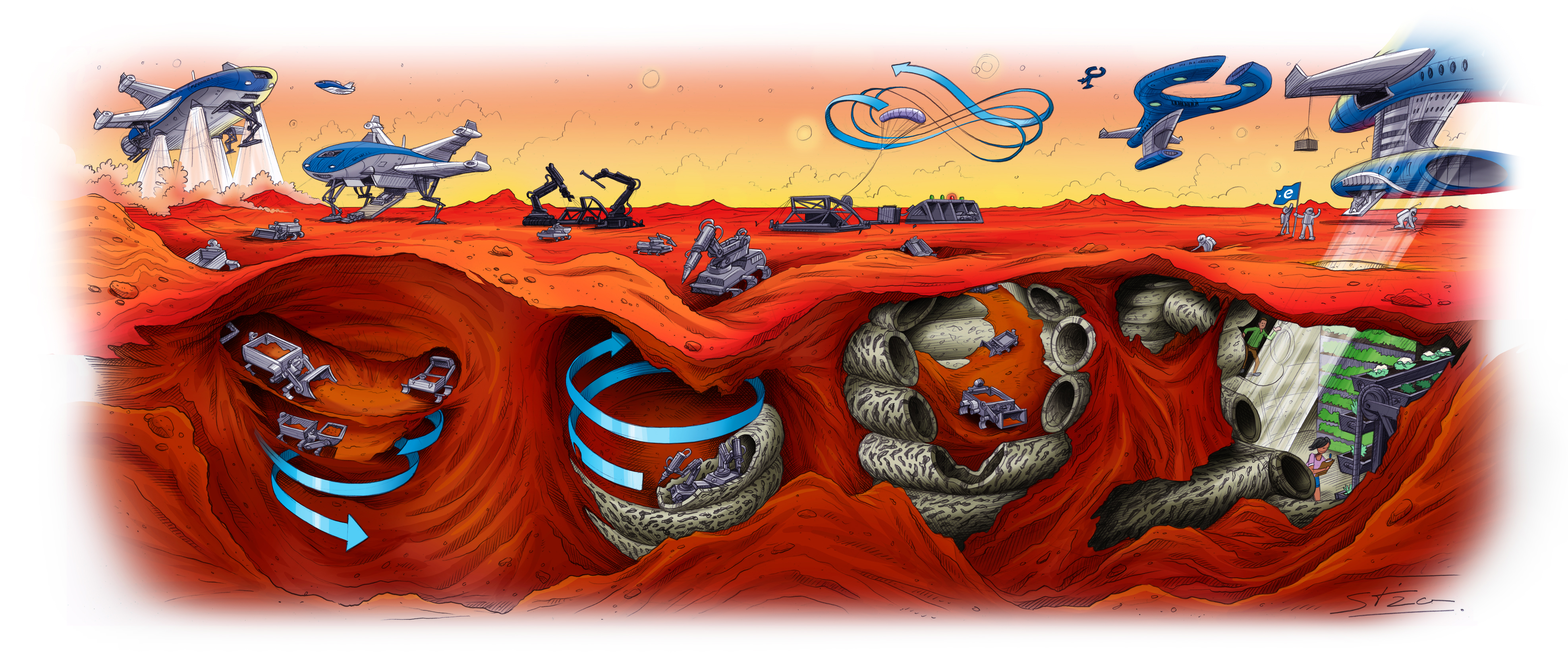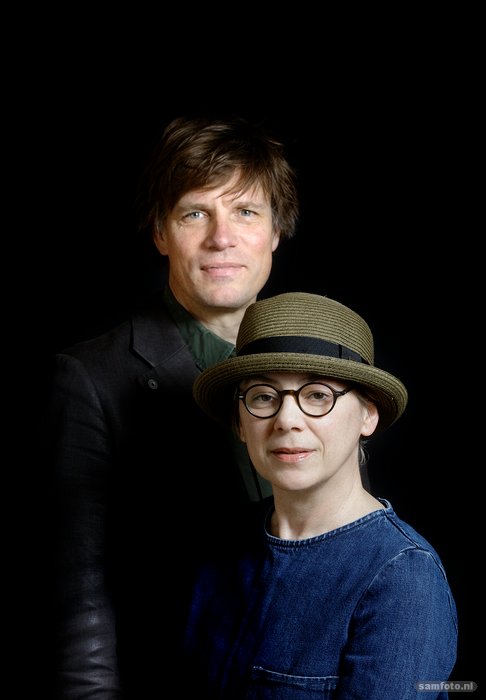Will the first Martians be robots?
Start by sending a swarm of robots to Mars to prepare the way for human pioneers. This was the plan that took Henriette Bier and Roland Schmehl to the second round of an ESA Discovery programme ideas contest this spring.
If it all goes ahead, the first Mars pioneers can look forward to an amazing stay after an eight-month journey. The shiny round windows on the surface of Mars will already be visible from their Mars lander (9). Still a bit stiff, they walk to the entrance in their space suits. Luckily, gravity here is less than half that on earth. Dust and sand blow against their visors and around their boots. Behind them, kites fly in figures of eight in the red sky (7). A hatch provides access to a narrow tunnel. The corridor slopes gradually downwards before bending left. After a few more turns, they reach the end of the tunnel, and enter an egg-shaped space with rough walls (10). Daylight comes in from almost ten metres above. This rounded, almost sacred space, is one of many. Together, they constitute the accommodation for the first generation of Mars pioneers, who can now start setting things up, growing food, and getting on with whatever prompted them to come here.
This arrival on Mars might sound like science fiction, but the underlying idea did take TU researchers Henriette Bier (BK) and Roland Schmehl (AE), together with students and colleagues, to the second round of the ESA Discovery programme. Bier and Schmehl, both from Germany, live under the same roof. At the Faculty of Architecture and the Built Environment, they developed methods for robots to build structures that often look surprisingly organic. At the Faculty of Aerospace Engineering, he conducts research into energy generation with large kites (up to 100 m2 and potentially larger) – proceeding from an idea conceived by the late Wubbo Ockels.
Rootstock
It should be no surprise that builder robots and energy-generating kites are at the basis of the plan Rhizome: Development of an Autarkic Design-to-Robotic-Production and Operation System for Building Off-Earth Rhizomatic Habitats, involving eight researchers and students apart from Bier and Schmehl. Rhizome is the botanical term for a rootstock with buds from which new plants emerge. Apart from the similarities of form, the symbolism must also have played a role in the name choice.
The robotic building workshop of the BK City building contains examples of such small rhizomes. They consist of double-walled half domes with a complex internal structure produced by a robot in a 3D printing process. The researchers continue to be inspired by the porosity, complexity and variety of surface structures afforded by robotic building. Bier praises “the potential of robots for improved structural performance, reduced material consumption, increased production speed and enhanced insulation properties.”
Molebots
The rhizomes owe their rigidity and load-bearing capacity to the internal structure between the inner and outer walls. On Mars, excavation robots will first start (2) digging tunnels in the ground. Schmehl jokingly refers to them as molebots. The debris and material left behind by the molebots can be combined with molten sulphur to form a kind of Mars concrete that can be used to reinforce the tunnel walls (5). Bier believes there is sufficient sulphur and suitable material (regolith) on Mars to build in this way. The internal bearing structure is formed by helical tunnels (3) which create the cavities in the dome-shaped structures.
Working together as a swarm, the robots excavate, remove material, inject and print Mars concrete with a 3D printer (6). This type of co-operation between robots is inspired by collective behaviour in nature, such as flocks of birds flying in formation or termites that build structures thousands of times bigger than themselves. The robots intercommunicate, each knowing its role, and the whole is greater than the sum of its parts. The loss of a few robots, birds or ants here or there will not really affect the result.
The swarm first works together in a coordinated manner to create tunnels in increasingly wide circles and then gradually makes increasingly small ones before coming together again at around ten metres below the surface. The result is an ovoid structure in the Martian ground. When all the material has been removed from the interior of this egg (8), and a window has been placed at the surface, the rhizome becomes visible.
The robots excavate, remove material, inject and print Mars concrete with a 3D printer
Exploration
Obviously, the robots will need energy to do all that. With the German aversion to nuclear energy, that wasn't an option. And there is little sunlight there, so solar energy could also be discounted. The air density on Mars is low (less than 1% of the earth's atmosphere), but the average air velocity is high (force 4-5). Together with a team of students, Schmehl is going to design a renewable energy system (4) that is optimised for use on Mars.
About ten TU Delft students can sign up to help work on this project. At Architecture and the Built Environment, twenty students participated in a Robotic Building workshop to explore the design and materialisation of accommodation on Mars.
The results will be presented this year as a detailed proposal for the next round of the ESA Discovery contest.

